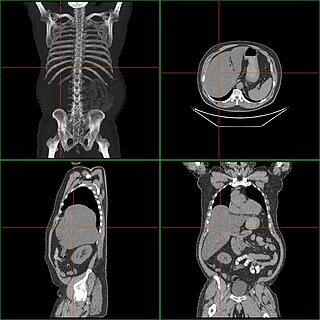Hepatomegaly
Enlargement of the liver From Wikipedia, the free encyclopedia
Hepatomegaly is enlargement of the liver.[4] It is a non-specific medical sign, having many causes, which can broadly be broken down into infection, hepatic tumours, and metabolic disorder. Often, hepatomegaly presents as an abdominal mass. Depending on the cause, it may sometimes present along with jaundice.[1]
| Hepatomegaly | |
|---|---|
 | |
| Computerized tomography of affected person with hepatomegaly | |
| Specialty | Hepatology |
| Symptoms | Weight loss, lethargy[1] |
| Causes | Liver abscess (pyogenic abscess), Malaria[1] |
| Diagnostic method | Abdominal ultrasonography[2] |
| Treatment | Prednisone and azathioprine[3] |
Signs and symptoms
The patient may experience many symptoms, including weight loss, poor appetite, and lethargy; jaundice and bruising may also be present.[1]
Causes
Summarize
Perspective

Among the causes of hepatomegaly are the following:
Infective
- Glandular fever (Infectious mononucleosis)[1]
- Hepatitis (A, B, C)[4]
- Liver abscess (pyogenic abscess)[1]
- Malaria[1]
- Amoeba infections[5]
- Hydatid cyst[6]
- Leptospirosis[7]
- Actinomycosis[8]
Neoplastic
Biliary
Metabolic
Drugs (including alcohol)
- Alcohol use disorder[4]
- Drug-induced hepatitis[1]
Congenital
Others
- Hunter syndrome (spleen affected)[11]
- Zellweger's syndrome[12]
- Carnitine palmitoyltransferase I deficiency[13]
- Granulomatous: Sarcoidosis[14]
Mechanism
The mechanism of hepatomegaly consists of vascular swelling, inflammation (infectious in origin), and deposition of (1) non-hepatic cells or (2) increased cell contents (such as that due to iron in hemochromatosis or hemosiderosis and fat in fatty liver disease).[15]
Diagnosis
Summarize
Perspective


Suspicion of hepatomegaly indicates a thorough medical history and physical examination, wherein the latter typically includes an increased liver span. [citation needed]
On abdominal ultrasonography, the liver can be measured by the maximum dimension on a sagittal plane view through the midclavicular line, which is normally up to 18 cm in adults.[2] It is also possible to measure the cranio-caudal dimension, which is normally up to 15 cm in adults.[2] This can be measured together with the ventro-dorsal dimension (or depth), which is normally up to 13 cm.[2] Also, the caudate lobe is enlarged in many diseases. In the axial plane, the caudate lobe should normally have a cross-section of less than 0.55 of the rest of the liver.[2]
Other ultrasound studies have suggested hepatomegaly as being defined as a longitudinal axis > 15.5 cm at the hepatic midline, or > 16.0 cm at the midclavicular line.[17][18]
Workup
Blood tests should be done, especially liver-function tests, which give a good impression of the patient's broad metabolic picture.[medical citation needed]
A complete blood test can help distinguish intrinsic liver disease from extrahepatic bile-duct obstruction.[19] An ultrasound of the liver can reliably detect a dilated biliary-duct system,[20] it can also detect the characteristics of a cirrhotic liver.[21]
Computerized tomography (CT) can give accurate anatomical information for a complete diagnosis.[22]
Treatment

Treatment of hepatomegaly varies with the cause, so accurate diagnosis is the first concern. In auto-immune liver disease, prednisone and azathioprine may be used for treatment.[3]
In lymphoma the treatment options include single-agent (or multi-agent) chemotherapy and regional radiotherapy, and surgery is an option in specific situations. Meningococcal group C conjugate vaccine is used in some cases.[23]
In primary biliary cirrhosis, ursodeoxycholic acid helps the bloodstream remove bile, which may increase survival.[24]
See also
References
Further reading
External links
Wikiwand - on
Seamless Wikipedia browsing. On steroids.
